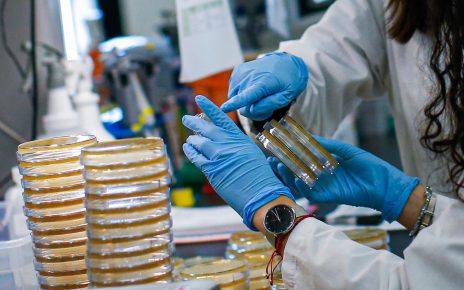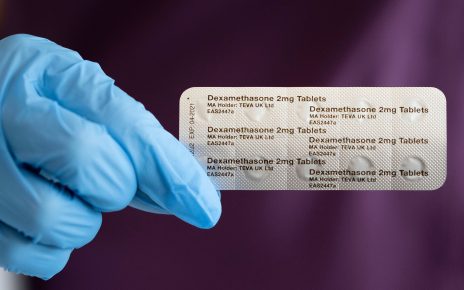This feels like a lopsided fight. In one corner, we have scientists, epidemiologists, infectious-disease physicians, clinicians, engineers—many different experts in the medical community, that is—arguing that the spread of COVID-19 by aerosols (that is, tiny droplets that can remain airborne long enough to travel significantly farther than the six-foot separation we’ve been told to observe) is both real and dangerous. In the other, it’s the Centers for Disease Control (CDC) and the World Health Organization (WHO), which until very recently have allowed only that aerosol spread is possible, not necessarily likely.
And while watching experts going against governmental agencies isn’t always riveting stuff, this particular battle is terribly important. It has significant implications for how we as a country handle this epidemic, and what decisions we make going forward—and those decisions need to be made sooner, not later.
On some level, this is a discussion of droplets versus aerosols. You’ve probably heard plenty this year about droplets: they’re larger in size and may be exhaled by someone talking, shouting, singing, coughing or sneezing. These droplets don’t travel far and fall quickly to the ground, one reason why a “social distance” of roughly six feet is seen as a safe one.
Aerosols, on the other hand, are tiny by comparison, nearly 10,000 times smaller than a human hair. They’re spread at far greater distances—20 to 30 feet—and can linger in the air for minutes to hours, infecting others. What constitutes a safe distance from aerosols is much harder to define, especially in crowded indoor spaces with poor ventilation. Choosing a safe mask becomes difficult as well: an N95 respirator, for example, would be preferable to an ill-fitting cloth mask when it comes to filtering out these minuscule viral aerosols. For these and other reasons, some in the medical community suspect, our health agencies have been reluctant to accept the data on the airborne transmission of COVID-19—because if they do, they’re acknowledging a problem far more challenging even than what we’ve been dealt with so far.
This reluctance has prompted an epic response. In a nearly unprecedented move, 239 scientists from 32 countries wrote an open letter to the WHO in July, urging the agency to recognize that airborne transmission of coronavirus by smaller aerosol particles is possible. The organization’s response was to subsequently update its position, stating that aerosol transmission “cannot be ruled out.” A glowing endorsement this was not. The CDC, meanwhile, posted on its Web site over the weekend that aerosolization may be “the main way the virus spreads,” then backtracked and removed the content from its site, claiming the language had been a draft of some proposed changes which were “posted in error.”
This is a major point, not a minor one. Aerosol carry of the virus means that any indoor area where people gather in numbers—think restaurants, bars, churches, schools, rallies—is potentially a spreader of the disease, and depending upon the numbers, a superspreader. These are likely places with poor ventilation, where people not only are close together but may be speaking loudly, shouting, singing, cheering or booing, etc.
The idea of aerosol spread is neither new nor controversial. Several diseases, including measles, chickenpox and tuberculosis, have been shown to be transmitted by aerosols. Patients sick with the flu have the virus in their exhaled breath, and that virus has been shown to be present in the air. This is true for some other viruses, including those found in infants. Scientists in Wuhan, China, have identified coronavirus RNA particles in the air in hospital areas, although they haven’t yet proven that the particles are infectious. Lab workers at the University of Nebraska have published their finding that they, too, have identified coronavirus RNA in the air.
“We have pretty strong circumstantial evidence, in a number of these superspreading indoor incidents, that there must have been a significant component of aerosol or airborne transmission,” says William Bahnfleth, chair of the American Society of Heating, Refrigerating and Air Conditioning Engineers (ASHRAE) Epidemic Task Force. Bahnfleth noted several examples, including a restaurant in Guangzhou, China, where multiple people without direct contact with one another became infected from a single individual, and a choir practice in Washington state where presumed droplet and aerosol spread from singing sickened 53 people, two of whom died.
In an e-mail interview, researcher Bjorn Birnir shared his work, published in a preprint (a non–peer reviewed paper), that demonstrated how an infected person continues to exhale a cloud of droplets and aerosols. These “build up over time to dangerous concentrations for everyone in the room,” Birnir says. While we don’t know exactly how much virus is needed to infect people or at what concentrations, these examples show that at some point the threshold is met and inhaled aerosols are the likely culprits.
“Aerosol transmission plays a significant role in indoor environments and cannot be neglected,” says environmental science expert Maosheng Yao, a professor of engineering at Peking University. “Sooner or later, [the WHO] is going to recognize this officially.”
Much of the solution to the challenge of aerosol (and droplet) transmission in indoor areas is ventilation. “If people use recirculated air during a pandemic, it is going to be dangerous, because you will just circulate the virus around,” Yao says. The goal of ventilation, instead, is to exhaust air from inside a building—along with whatever contaminants it contains—and replace it with clean air from the outside.
One great way to do this, according to Yao and the CDC, is to increase outdoor ventilation by opening windows and doors. Experts say this can make a huge difference in air flow rates in buildings. “Open all the windows possible. The outside air has a much bigger diluting capacity because there is a big space,” says Yao. In some instances, Bahnfleth says, a fan can be placed near one window while other windows are left open in order to create forced ventilation.
Nothing is perfect, of course. Ventilation can be expensive, depending upon what is needed, and some of the recommendations may use significant amounts of energy. Fans in HVAC (heating, ventilation and air conditioning) systems are limited in the amount of outside air exchange they can do—but more is better, and the ASHRAE guidelines recommend that the units be kept running for longer hours, 24/7 if possible.
High efficiency air filtration and disinfection are important. Filters should be upgraded to the extent possible in HVAC systems without diminishing airflow. The ASHRAE paper recommends MERV-13 filters or the highest level allowable, which filter very small infectious particles. And if HVAC units cannot use higher-grade filters, consider using portable air cleaners with HEPA (high-efficiency particulate air) filters to disinfect the air further.
A word about ultraviolet light. “A coronavirus is a coronavirus,” says Bahnfleth, and prior studies found that ultraviolet light inactivated other coronaviruses, like SARS-CoV-1 and MERS (Middle East Respiratory Syndrome). UV fixtures can be mounted on the ceiling or walls, or placed inside ventilation ducts to neutralize viruses and bacteria. The biggest limitation is that the irradiation can be a health hazard, to both skin and eye, which is why the fixtures are placed up high, away from people.
On this front, there is promise. A newer ultraviolet technology that employs a lower wavelength of light, called far-UVC light, appears to work without the potential health issues. In prior studies, far-UVC killed airborne flu virus, and in a study in Nature it was shown to inactivate other airborne coronaviruses. Based on the results, far-UVC exposure in occupied public areas would inactivate approximately 90 percent of the virus in eight minutes, and 99.9 percent by 25 minutes. Researchers expect it would work similarly against COVID-19. Let’s keep a close eye on this.
Other mitigation measures experts and the CDC recommend are masking indoors, being distanced, having fewer people indoors and potentially installing droplet barriers. The barriers, however, might interact with air flow patterns in a negative way. Bahnfleth recommends getting help from an expert to make sure that what is being installed is actually helpful.
And that’s it. Open the windows and the doors, beef up the HVAC circulation/outdoor air exchange, and consider letting the unit run 24/7. Install high-level filters if you can. Consider purchasing additional portable air cleaners, bring fewer people inside the building, and employing ultraviolet technology.
Governing agencies’ reluctance aside, preventing indoor person-to-person aerosol spread of COVID-19 could be a game changer. Good ventilation alone should help avoid some of the superspreading events we’ve seen, and help all of us get back to the normalcy we crave. With airborne COVID-19 transmission, there is a lot more we can do besides mask, social distance and wash our hands. It’s time to step up our game and think more like the engineers who are trying to help us solve this problem.



